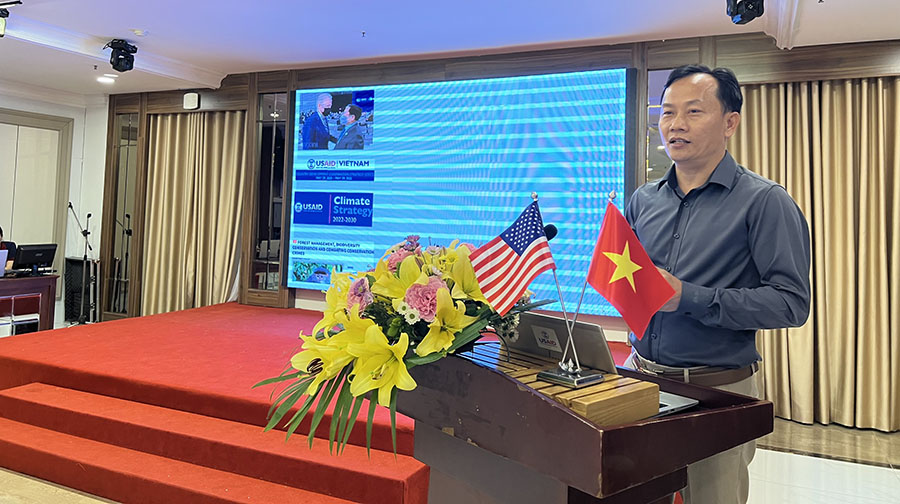DEVELOPMENTS
Q&A with the Experts: Why Forest Conservation is Such a Huge Opportunity
Aug 9, 2022
Thomas Erdmann is a Principal Global Practice Specialist in DAI’s Climate Change and Natural Resources Management Practice. Teo Dang Do is Deputy Chief of Party for the U.S. Agency for International Development (USAID) Vietnam Sustainable Forest Management Activity. DAI sought out their perspectives on why forest conservation matters.
First, why is forest conservation so important?
 Tom: “Forests are important for many reasons. Beyond climate change mitigation via carbon sequestration, forests are critical for providing other environmental services, such as water regulation. Forest ecosystems also harbor a large percentage of the world’s biodiversity, and they provide key economic products, like timber and lumber, firewood, and non-timber forest products (fruit, nuts), and they have recreational value. In short, forests are multifunctional—hence the importance of conserving and restoring them.”
Tom: “Forests are important for many reasons. Beyond climate change mitigation via carbon sequestration, forests are critical for providing other environmental services, such as water regulation. Forest ecosystems also harbor a large percentage of the world’s biodiversity, and they provide key economic products, like timber and lumber, firewood, and non-timber forest products (fruit, nuts), and they have recreational value. In short, forests are multifunctional—hence the importance of conserving and restoring them.”
Teo: “Forests offer enormous financial value. Globally, the estimated total value of the world’s forests is around $150 trillion. And they present a massive opportunity for job creation. Globally, forests could create $230 billion in business opportunities and 16 million jobs worldwide by 2030. In Vietnam alone, as of 2018, there were more than 11,000 enterprises operating businesses relating to timber and forestry, employing approximately 505,000 workers, according to USAID’s Green Annamites Project. CO2 emissions reductions and carbon sequestration within the forestry sector enable the Government of Vietnam to fulfill its commitment to achieving neutral carbon by 2025. Lastly, research shows that more biodiversity (including in forests) can decrease the likelihood of wildlife-to-human disease transmission that occurs when humans encroach upon natural habitats.”

Teo Dang Do makes a presentation in Vietnam.
What inspired you to get into forestry?
Tom: “I have always been a nature lover; my family, especially my maternal grandmother, instilled this love in me at an early age. I started planting trees during summers in high school and college, working for a landscaping company. This led to a Peace Corps job as an agroforestry volunteer in Mali and Rwanda, which reinforced my love for forests. After Peace Corps, I went to grad school at the University of Florida, earning an M.S. in forestry with a specialization in agroforestry.”
Teo: “Like many local high school pupils in my rural mountainous village, Gia Thanh, in central Vietnam, I had not considered the power of forestry until my family relied on cutting trees, and burning, producing, and selling charcoal for a daily living since 1985. Eight years later, forestry resources in my family were gradually depleting due to heavy charcoal and brick production. To address this environmental issue, I enrolled in the agriculture and forestry undergraduate program at Hue University. After that, I started my career journey with different sustainable natural resources management activities, focusing on forestry conservation. After more than 20 years working on sustainable forestry in Southeast Asia and Africa, I found that the more I worked, the more I struggled to find the optimal approach to achieve the ‘triple bottom line.’ I decided to enroll in the master’s program for international development at Clark University and later pursued my Ph.D in development management in Bangkok, Thailand, focusing on sustainable financing mechanisms, especially payments for forest environmental services.”
Where do you think sustainable forestry is working best?
Tom: “Where there is a developed and responsible forest industry coupled with good and environmentally sound oversight and engaged local communities. The Forest Stewardship Council model of certified forest management has always appealed to me, though I wish it would have more of an impact in tropical forest ecosystems where most forest biodiversity is found. The European Forest Law Enforcement, Governance, and Trade model has also produced promising sustainable forest management results in places such as Liberia and Southeast Asia. Sustainable community forestry works best when the local communities and stewards have clear rights over forest resources, can gain economic benefits from the forests, and are supported by local and national government policy and forest services as well as an effective national-level apex organization. Perhaps the most successful model is in Nepal, with community forest users groups.”
Teo: “It is quite challenging for me to determine where sustainable forestry is working best. Personally, I think the forest in Central Annamites (especially Quang Nam and Thua Thien Hue provinces) is still effectively conserved, for six main reasons: political willingness; strong and responsible leadership; stable institutional arrangements; competent personnel and active forest rangers; appropriate and timely strategies, policies, and programs on sustainable forest management; and advanced law enforcement practices.”

Ground forest clearance in the Forest Stewardship Council forest of Quang Tri province. Photo: Cintapo.
What are the greatest near-term and long-term challenges?
Tom: “Near-term challenges for community forestry revolve mainly around devolution of rights to community forest management organizations. Supporting local managers is critical as they begin to exercise management rights; they often need training to develop and implement management plans and need back-up from government.
“The longer-term challenges revolve around sustainability and economic benefits. Harvesting and offtake levels need to be carefully monitored over time to ensure the resources can regenerate and keep providing products over time. Economic benefits are also key.”
Teo: ”A baseline study by USAID’s Vietnam Sustainable Forest Management Activity found six main challenges facing forest conservation: (i) illegal logging; (ii) hunting and trapping; (iii) over-harvesting non-timber forest products; (iv) forest land encroachment; (v) infrastructure development; and (vi) mineral resource extraction. The first three challenges are considered near-term challenges, and the remaining are long-term challenges for private sector engagement.”
What are the greatest opportunities or recent innovations?
Tom: “The concept of reducing emissions from deforestation and forest degradation (REDD+) still holds great promise. Payments to local communities and stewards for sequestered forest carbon can provide a critical incentive for conserving and preserving large swaths of forest. If we can demonstrate the proof of concept in a couple of places—carbon payments trickling down to local communities and stewards, who then reinforce their efforts to protect forests in their backyards—I think this could have a huge positive impact for forest conservation.”
Teo: “From a policy angle, I found the Government of Vietnam and forestry scholars have had a paradigm shift from forest protection and biodiversity conservation to natural resources economic management, recognizing the key role of the private sector. One of the greatest opportunities is that the Government has shown its very strong commitment to addressing climate change issues and achieving the goal of being carbon neutral by 2025, as declared by the Prime Minister H.E. Pham Minh Chinh at COP 26. To contribute to achieving this ambitious goal, the forestry sector has a huge opportunity to reduce emissions and enhance sequestration of CO2. The public-private community market-based approach has also been widely applied in Vietnam with support from USAID.”

Signing of a partnership agreement between SFM and the Tien Phuoc Dried Betel Nut Cooperative in Quang Nam province. Photo: A. Lang Nguoc.
Lastly, what actions can we take in our organizations—and as individuals in our daily lives—to promote forest conservation?
Tom: “Look at national policy with respect to forest conservation as a starting point and try to support those efforts. Nationally Determined Contributions to the United Nations Framework Convention on Climate Change may be a good place to begin as they may include climate change mitigation measures via forest carbon sequestration. Engaging with local environmental nongovernmental groups can be another good entry point.
“Two ‘daily life’ actions come to mind. First, choose recycled paper products and choose paper products over plastic whenever possible. Second, look for products (paper, wood, wood furniture) that have credible eco-labels, such as those from the Forest Stewardship Council, indicating that the products come from sustainably managed forests.”
Teo: “In our work, we can quantify the monetary value of forests and ecosystem services to easily communicate with non-technical audiences. We can improve coordination among key stakeholders and agencies by applying multidisciplinary and multistakeholder approaches.
“In my daily life, I teach my children and relatives to consider environmental issues when printing documents. We can conserve forest products and plant more trees. Around the world, we can show our appreciation for forests by simply paying for our utilities. This increases payments for environmental services as a ‘socialization initiative to pay forward,’ which helps support investments in forest conservation.”
Sallie Sherman is an Opportunity Coordinator for DAI’s Environment practice.